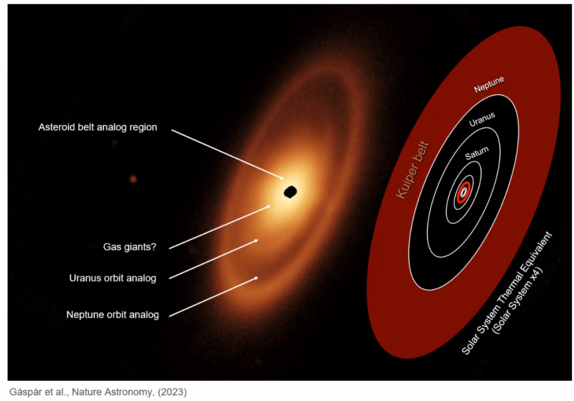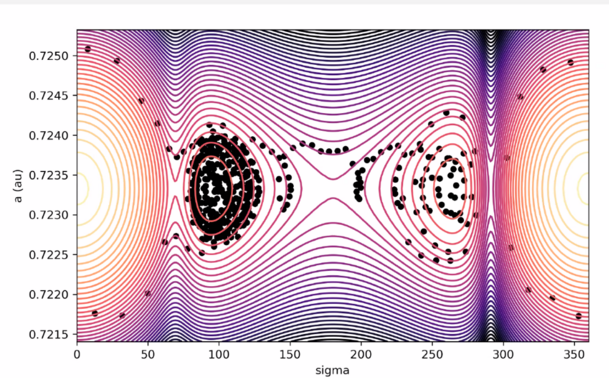From skimming titles, it looks like the session on TNOs/Centaur dynamics is mostly about measuring ices on these bodies (which is cool [haha literally] but not my thing). So, I'm going to try the software session and see what neat stuff is happening there!
X. Yan: Modelling hypervelocity impacts with new code - beautiful movies showing their code really nicely reproduces laboratory hypervelocity impacts
S. Stetzler: finding fast, faint small bodies in a TNO survey (DEEP). Incredibly computationally intensive to find the fast-movers in image stacks, has a neat statistical technique for finding "clusters" in data, code here: https://github.com/stevenstetzler/robust_linear_regression
At higher signal-to-noise, this is hugely faster/more efficient than traditional digital tracking. Expect to detect ~10,000 asteroids in their DEEP TNO data, wow (maybe we should try this with the survey I'm co-leading...hm...)
GitHub - stevenstetzler/robust_linear_regression: Python implementation of robust linear regression in the multiple regression and multivariate regression cases using the minimum covariance determinant (MCD).
Python implementation of robust linear regression in the multiple regression and multivariate regression cases using the minimum covariance determinant (MCD). - GitHub - stevenstetzler/robust_linea...
M. Stanescu: nice title "Blink and you miss it" - finding potentially hazardous asteroids, which move really fast across the sky. Using GPUs, can do synthetic tracking in real-time (used to be very slow). Using a $650 computer for this, entire code only takes a few minutes to run, about the same as exposure times.
Also have a fast web interface (but I couldn't find it...)
Detection code here: https://github.com/mostanes/umbrella2
M. Payne: overview of the Minor Planet Center. Have 12 employees now (currently hiring!) to keep track of every small body in the solar system. Have a newsletter now: https://www.minorplanetcenter.net/mpcops/new/newsletters/
Now have DOIs for MPECs (where new small bodies are announced)
TESS has submitted 30 million (!) observations they are currently working at processing, mostly already known objects, a few new ones.
New science highlight: 63 new Saturn moons!
Building new services like new ephemeris service
LSST and NEO Surveyor will have hundreds of millions of observations per year, MPC working on making their processing pipelines ready for this!
F. Spoto: MPC orbit fitting now uses OrbFit software (I think this is it: http://adams.dm.unipi.it/orbfit/)
Can finally publish orbital uncertainties, yay!
More code here: https://github.com/Smithsonian/mpc-public/tree/main/mpc_orb
New orbit comparison tool here to compare orbits between MPC and JPL databases, see errors on measurements, more: https://data.minorplanetcenter.net/orbit-comparison/compare_neos.html
W. Byrne: identifying spokes in rings of Saturn, comparing machine learning and human-designed algorithms. Conclusion: both processes seem viable, haven't fully tested limits yet, so that's the next step.
Next session has 2 parallel sessions that I really want to see talks from! I'll have to do some jumping back and forth between Zoom sessions (extra thank you to conference organizers for making this possible to do from home)
S. Wolff: Fomalhaut's exo-asteroid belt as seen by JWST!! (I wrote more about this here: https://www.astronomybynight.ca/the-curious-case-of-fomalhaut-b/)
Debris disks are detected as radiating dust, mostly in IR. Fomalhaut has "eye of Sauron structure". Dust they observed is way more complex than predicted, especially the "intermediate belt" that wasn't previously seen. Fom b not detected - "great dust cloud" is just a stupid background galaxy.
The fact that inner part isn't cleared tells us about properties of planets
Arc-like structures seen could be explained by mean-motion resonances or maybe recent collision.
Just starting on dynamical modelling work - lots to come. Can't directly see the planets, but there must be planets causing the dust structures that are observed. Will have more JWST images of Vega and eps Eri, other stars with neat, big disks.
R. Deienno: giving talk for A. Izidoro who couldn't make it.
Some models suggest asteroid region was originally empty, and everything there migrated. Inner planets could kick out asteroids to present location in ~100Myr. But giant planets scattered then, what happens?
As long as there's a delay of 10-100Myr, it puts asteroids in the right place. So, this could possibly match what we see.
M. Holman: pretty much everybody uses JPL Horizons https://ssd.jpl.nasa.gov/horizons/app.html#/ for getting small body ephemerides, but code is not open source.
Want to make an integrator that matches Horizons and is open source and uses firehose of upcoming data.
New code based on REBOUND https://rebound.readthedocs.io/en/latest/ (everyone uses, well documented, thanks @hannorein), called ASSIST
Extensively tested with Horizons to make sure it matches and is accurate, and tested with forward/backward integrations.
Code did great on test of Apophis close encounter in 2029, and on a close encounter between Ceres and 5303 Parijskij - so you can use ASSIST to calculate asteroid masses
Code is here! https://github.com/matthewholman/assist
Now working on artificial satellites (to make sure they aren't misidentified as small bodies)
R. Melikyan: lots of giant catastrophic collisions early in planet formation process that makes lots of pieces of debris (hello, Moon!)
New database of giant impact simulation results will be available soon (paper in revision), lots of sizes of impactors and targets (and cores), velocities, impact parameters. Debris that's created depends on all of this, high enough resolution to get debris size distributions.
These size impacts happened in early asteroid belt, sets initial sizes?
[session hop]
W. Grundy: Eris from JWST. Pretty much just methane, all over the place. Such a good spectrum you can measure deuterium ratio within the methane (whoa).
Looks at D/H ratio in lots of solar system bodies, but definitely a bit worrying to compare because measured so many different ways in different bodies...
D/H in Eris/Makemake is more like that in water than like organics. Thermally driven? Current subsurface ocean?? (big maybe, but neat!)
B. Sharkey: spectra of irregular satellites. Similar to asteroids/TNOs, but more frequent collisions between them. Are they captured from same population as Trojans? Probably, yes, but lots of spectral variation.
M. Schwamb @megschwamb: Colors of the Outer Solar System Origins Survey (Col-OSSOS, best acronym), colours from well-characterized survey OSSOS where biases are all measured. Effectively getting very low-res spectra of lots of TNOs.
Possible signs of tholins on surfaces? Looks a lot like asteroid spectra + extra reddening.
Need higher res spectra to really know, but that will be challenging because these TNOs are so faint.
[session hop]
N. Pan: very few asteroids known fully inside Earth's orbit, they're really hard to observe. About 30 known within 0.01 AU of Venus's semimajor axis. In 1:1 resonance?
Calculate grid of orbits to find stability range, found the nominal orbit for one object is within stable zone.
Next integrates nominal orbit - if Venus only, all clones in resonance. But when you add in other planets, only 25% in resonance.
Pretty level surface plot! Next: add Yarkovsky to sims
M. Sabat: `Oumuamua had no signs of coma/outgassing, but showed one of the highest non-gravitational accelerations ever measured for a comet. Why? (Not UFO, haha)
Did some more data mining in SOHO/SWAN Ly-alpha data - would show water/H2, nobody looked there yet. Tried co-adding data, got upper limit on water production rate - much lower limits than previously published, nice.
[from questions afterwards, seems like there are some contentious assumptions made here...]
S. Deam: measurements of interstellar comet Borisov thru perihelion. Had a little outburst in Mar 20, nucleus broke up a bit, whoa.
Measured dust colour, made dust and gas emission maps. Composition stays fairly constant even through outburst, though production rates went up after outburst (as expected)
The next talk was withdrawn so there's 12 minutes for everyone to ask questions and have a discussion about interstellar comets. Neat!
C. Gregg: which star systems might be most efficiently sending material our way? Need to take gravitational potential of the Milky Way as stars move thru disk over many orbits. Starting w/ burst of small bodies ejected at beginning of simulation. Lots of nice particle distribution movies!
Particles ejected from one star have similar galactic latitude and longitudes when they intersect our solar system. Lots of modelling still to do!
F. Adams: are there asteroids/comets in our solar system that were captured from other solar systems? Need captured #, and the lifetimes of these unstable captured orbit.
Walks through a lot of great simulations and analytics to calculate these...
Estimate about 10^-9 Earth masses in captured material, mostly tiny rocks
S. Desch: "This is my pandemic hobby. Some of you learned to knit or make bread, I learned to fight with Harvard astronomer Avi Loeb."
Doing real science with the ideas Avi Loeb is interested in (wow this talk is spicy - but Loeb is currently on a billionaire-funded trip to recover "interstellar" remnants off ocean floor yikes)
Can go thru bolide database to find bolides with impact velocities that might be interstellar (points out database velocities are extremely uncertain)
Estimates the impactor was beach ball sized- and probably *nothing* would survive to surface. Being generous, say that 1mg would land on surface. Uncertainties on landing at least ~10km radius, in middle of Pacific, as sink thru ocean will move by another ~10km
Yes, you can find micrometeorites by dredging w/ magnet. Will find at least 10,000x more regular old micrometeorites from previous impacts.
Ends by pointing out that Avi Loeb's poor science is actually contributing to the public's increasing lack of belief in science and increased belief in conspiracy theories :(
Y. Huang: did a survey: who believes there's a hidden planet in outer solar system - very few people raised their hand. He has bad news for Planet X fans, that planet was ejected billions of years ago.
Grainy migration, stellar flyby, existing planet all reproduce parts of Kuiper Belt, none reproduce all.
A ~earth mass planet that sticks around for a few 100Myr then gets ejected does a great job of populating resonances and detached populations.
Tested models with the OSSOS Survey Simulator (applies biases of survey to your model, then you can compare with real TNOs). Detached, distant resonant, and scattering populations all agree well! Estimates Sednoid population 250,000 D>100km, super hard to detect. Wait...he predicts clustering for a>120AU?? Interesting... I will have to send him an email...
Links to beautiful movies here: https://yukunhuang.com/download/videos/rogue-migration-sim-1-dda2023.mov
https://yukunhuang.com/download/videos/rogue-migration-sim-2-dda2023.mov
D. Gomes: previous studies have looked at gravitational effects of Planet X and if it could be ruled out. Wow, in model includes 8 planets, Solar mass and J2, 343 asteroids + 2 secular rings, Pluto + 2 secular rings, Jupiter Trojans, and more.
Can rule out >5 Earth mass planet at <400AU with data from Juno, Cassini, and Mars orbiters.
With that, my time at #ACM2023 is done (there's one more session but doesn't work with my schedule)
Hope you enjoyed reading my take on a lot of really amazing science that's happening!
Thank you!
@sundogplanets Have done a quick catch-up scan: outstanding.
Fully agree with Desch re: the Harvard Astronomer. It’s not clever & it’s not funny – it’s self-aggrandisement & deliberate personal cashing in at the expense of the further degradation of public trust in science.

